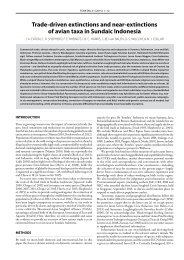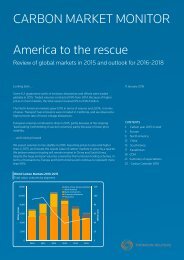Emissions Trading Worldwide
1TbjEHd
1TbjEHd
Create successful ePaper yourself
Turn your PDF publications into a flip-book with our unique Google optimized e-Paper software.
There is considerable room for simplification without affecting<br />
the robustness of the system<br />
In response to the growing concerns of ETS participants, Wilma<br />
Mansveld, the former Dutch Minister for the Environment, posed<br />
the following question:<br />
“How can the European <strong>Emissions</strong> <strong>Trading</strong> System be simplified,<br />
thus reducing the administrative burden for participants<br />
and/or the implementation burden for the government, without<br />
affecting the system’s reliability?”<br />
Examining this question, a recent study by the NEa finds that<br />
there are, in fact, many ways in which an ETS could be simplified.<br />
Focusing on the EU ETS, the NEa has identified seven general simplification<br />
strategies (see box), plus 28 practical measures, which<br />
could be implemented in a wide variety of ways. According to the<br />
research, most of these measures would have no, or very little,<br />
adverse effect on the robustness of the system. It would therefore<br />
be possible to simplify the EU ETS without unacceptably detracting<br />
from the reliability, security and central principles of the system.<br />
Indeed, efficiency could be increased by striking a better balance<br />
between risk and risk-control measures, by revising existing<br />
practices, and by taking steps to increase user-friendliness.<br />
“Seizing opportunities for simpli fication<br />
now can yield considerable long-term<br />
benefits. ”<br />
Two examples of simplification measures<br />
In some cases simplification measures may apply to small emitters,<br />
while in others they rather apply to ‘simple’ emitters. In the<br />
Netherlands, there are numerous installations where the monitoring<br />
methodology is relatively simple and very uniform, based on<br />
fuel invoices. Most of the installations concerned use natural gas<br />
in combination with small amounts of a secondary fuel (diesel).<br />
However, these emitters have to draw up extensive monitoring<br />
plans including risk analysis and control procedures. For such<br />
companies, simplified requirements for monitoring, reporting and<br />
verification would suffice.<br />
Another example concerns the CO 2 trading registry. Because of<br />
fraud incidents, the creation and amendment of registry accounts<br />
is subject to strict controls — and rightly so. However, many companies<br />
do not trade on a regular basis and only access the registry<br />
twice a year: once to enter their emissions and once to surrender<br />
their allowances. For them, an automated surrender of allowances<br />
managed by the registry could be introduced, much like the payment<br />
of a bill by direct debit. Such users would not need to access<br />
the account at all, and therefore would not have to meet the strict<br />
access requirements.<br />
Seven General Simplification Strategies<br />
Strategy 1 — Monitoring<br />
Simpler for simple emitters, more efficient<br />
for all participants<br />
Strategy 2 — allocation<br />
Shorter allocation periods, a more pragmatic<br />
approach to dealing with changes, a broader<br />
application at product benchmarks<br />
Strategy 3 — reporting and compliance procedures<br />
Back to basics with facilitation and automation<br />
Strategy 4 — registration<br />
More proportionality in security measures<br />
Strategy 5 — verification<br />
Less verification where justified<br />
Strategy 6 — facilities for information transfer<br />
Clearer and easier to use<br />
Strategy 7 — participation<br />
More logical and fairer<br />
These and 26 other simplification measures are described in<br />
detail in the report ‘A simple and effective EU ETS’ 2 by the NEa.<br />
These measures will be developed further in early 2016.<br />
A simpler ETS is a more future proof ETS<br />
In 2015, ten years after the introduction of the EU ETS, the EU<br />
Member States and the European Commission began outlining the<br />
shape that the system will take after 2020. Therefore, it is now the<br />
ideal time to take stock, to see what lessons can be learned from<br />
the last decade and to address the task of simplifying the system.<br />
Seizing opportunities for simplification now can yield considerable<br />
long-term benefits. For example, a simpler system would<br />
more easily allow emissions trading to be extended to other sectors<br />
with large numbers of small emitters. Simplification could<br />
also facilitate integration with ETSs in other parts of the world.<br />
Furthermore, it enhances transparency and helps build support<br />
for the system. Simplification of the EU ETS is thus an essential<br />
form of future-proofing.<br />
international carbon action partnership<br />
11




